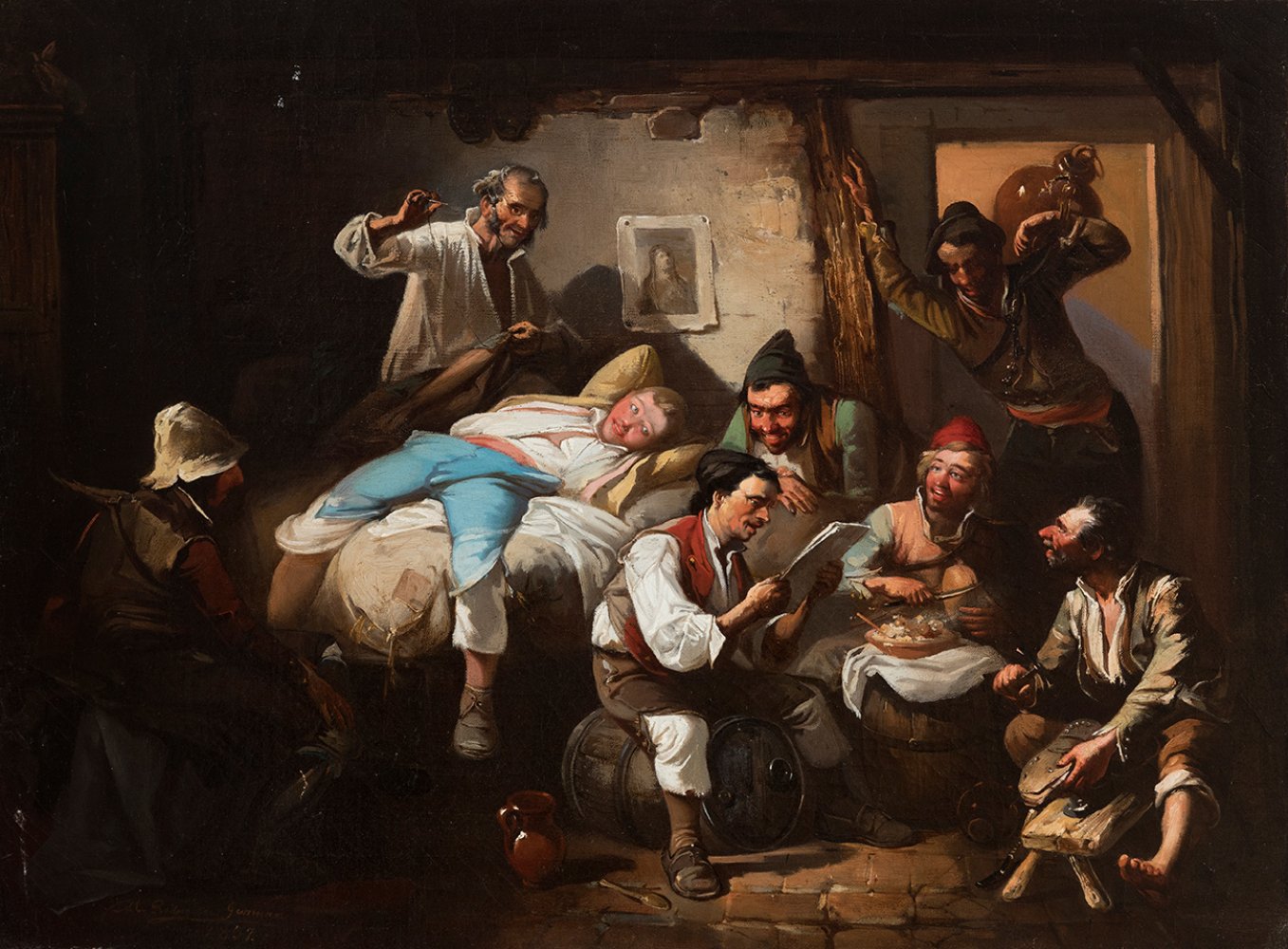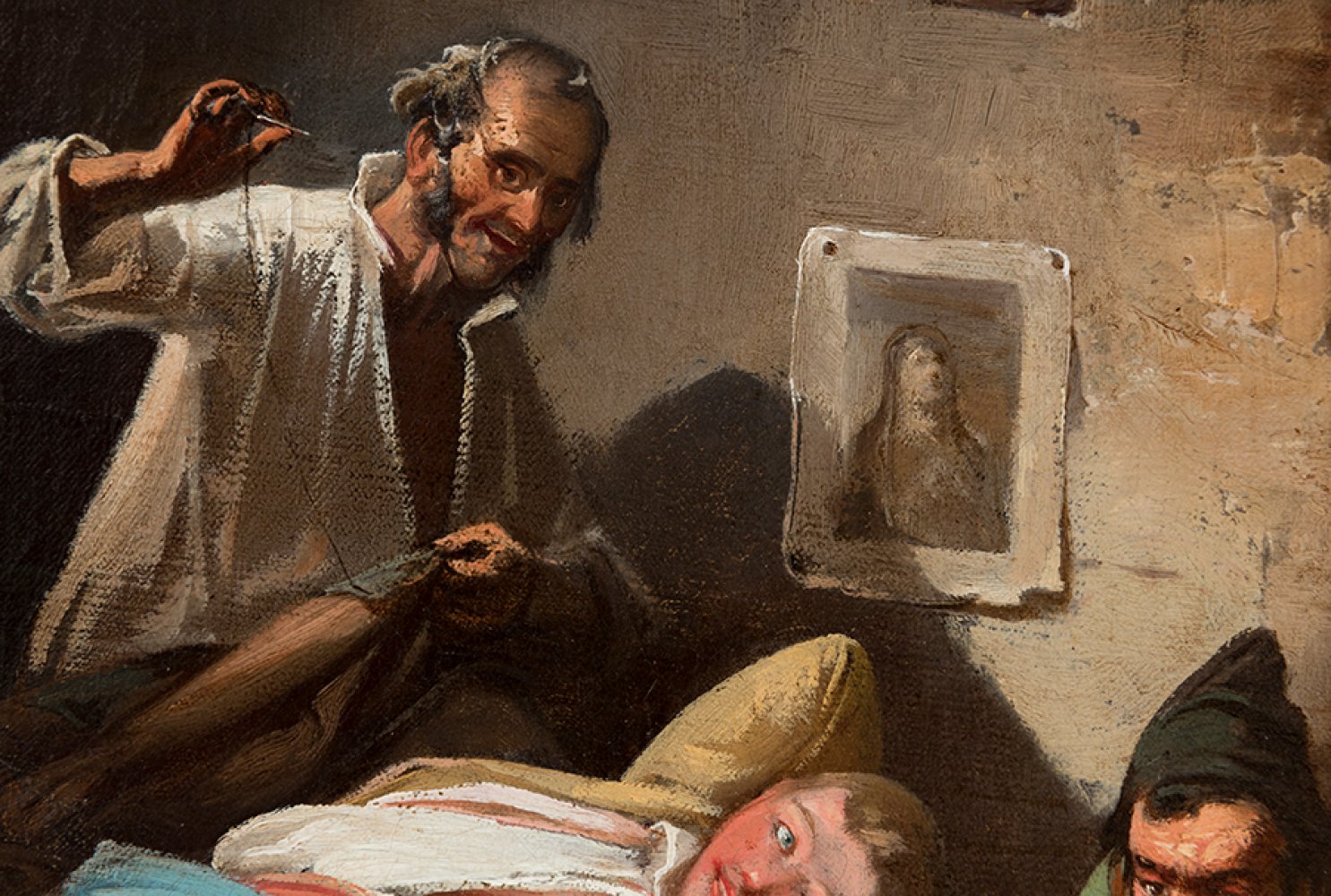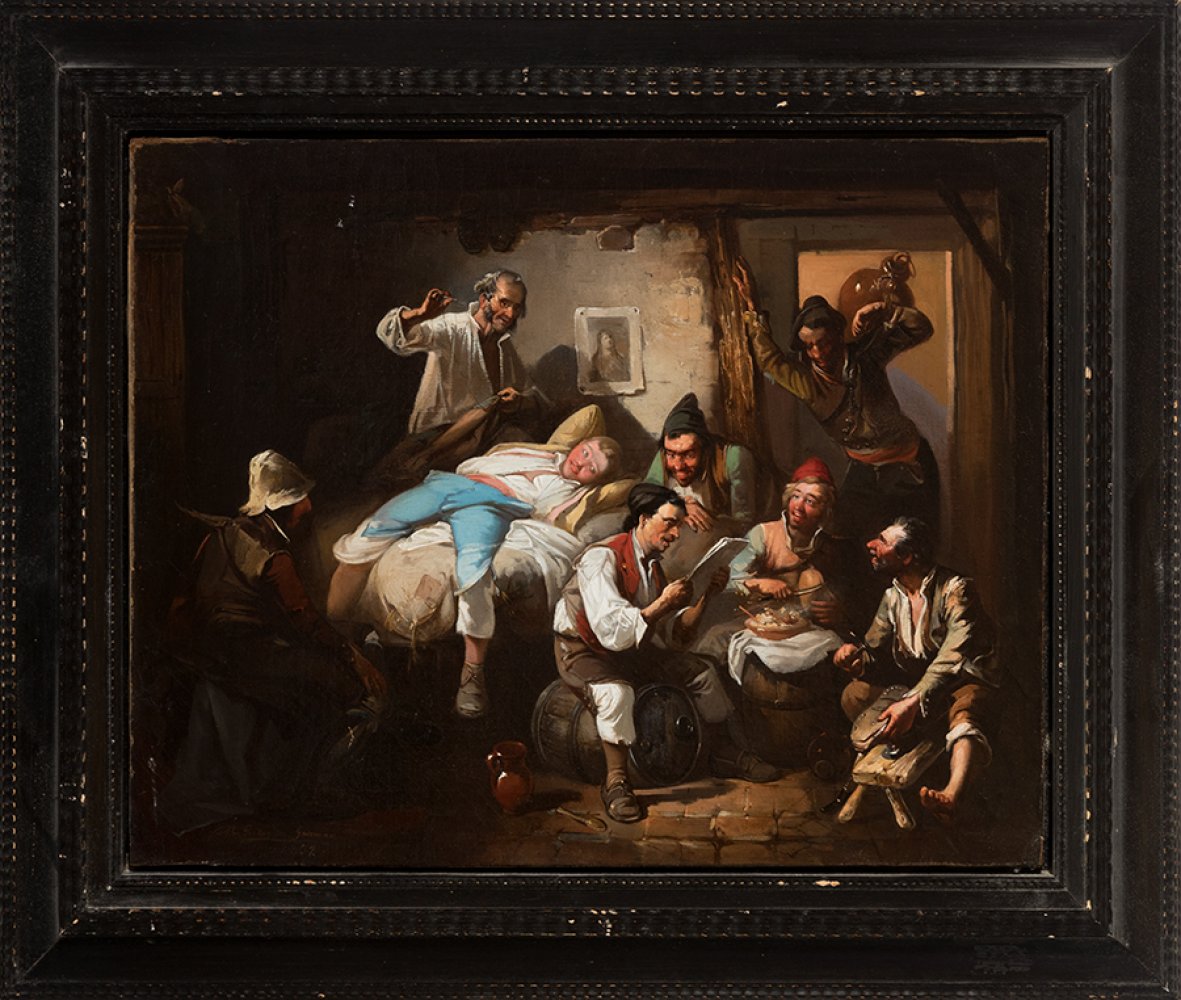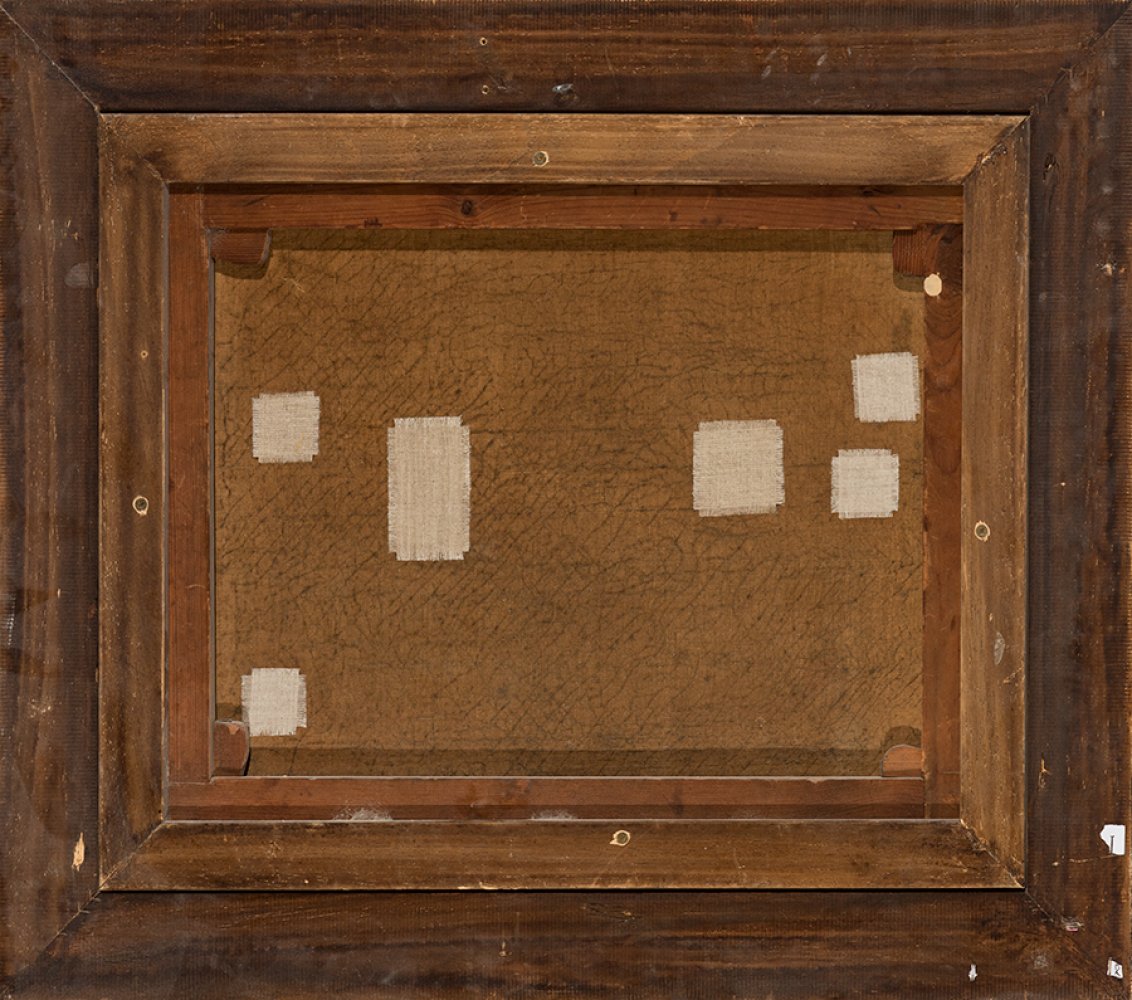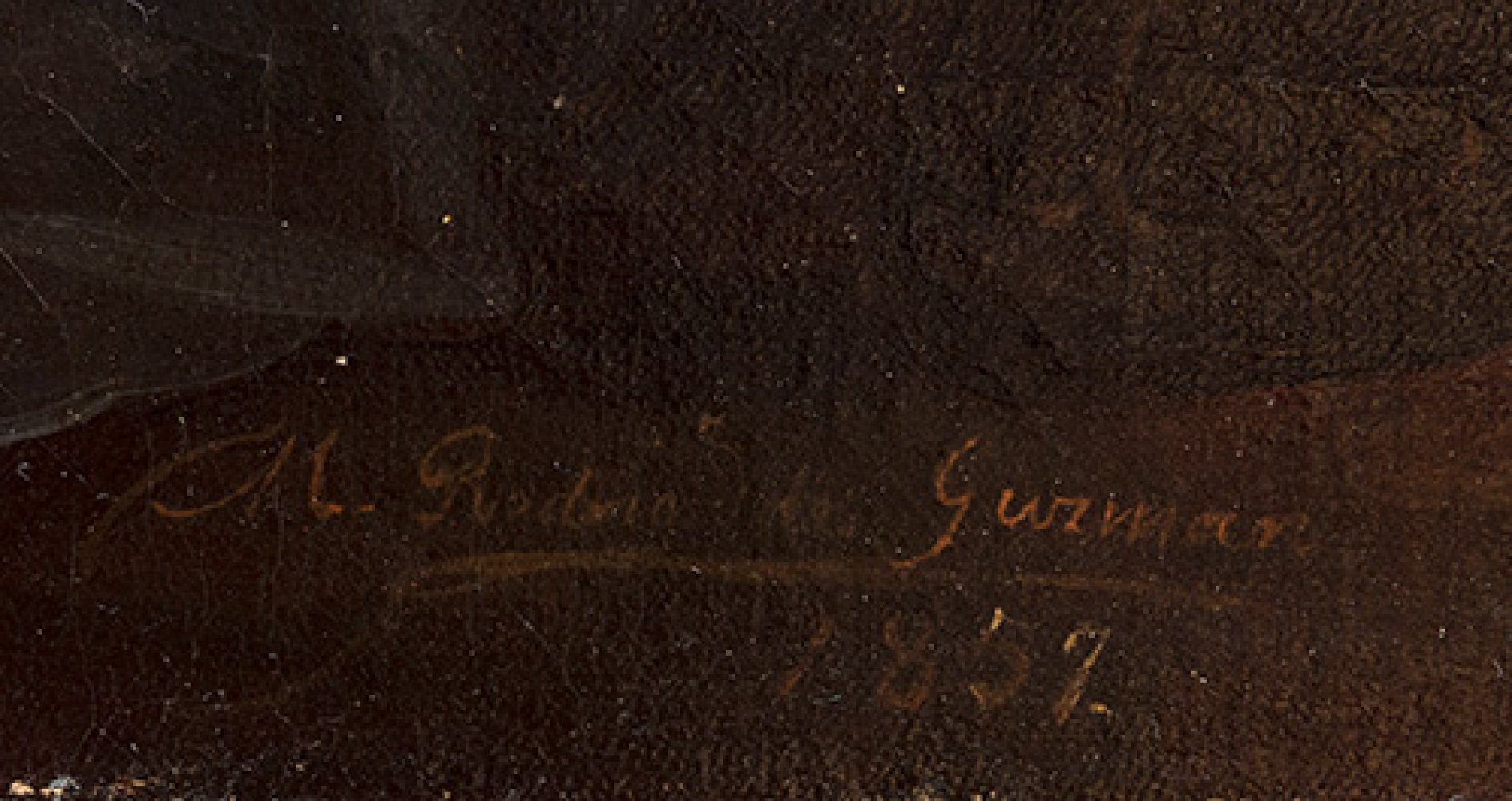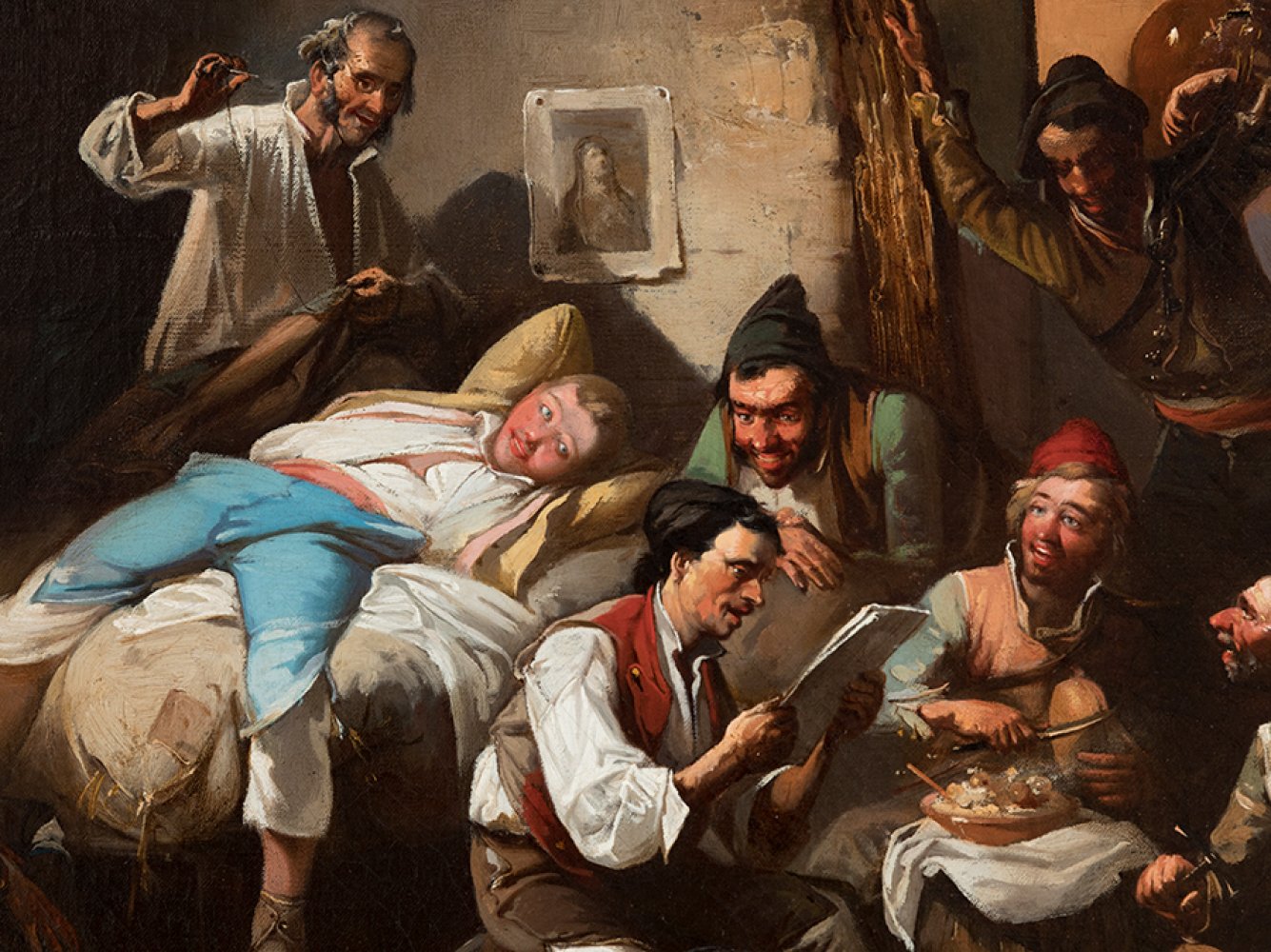1
MANUEL RODRÍGUEZ DE GUZMÁN (Seville, 1818 - Madrid, 1867)."Costumbrista Scene", 1857.Oil on canvas.
1/6
Description
MANUEL RODRÍGUEZ DE GUZMÁN (Seville, 1818 - Madrid, 1867).
"Costumbrista Scene", 1857.
Oil on canvas.
It has a perforation.
Signed and dated in the lower left area.
Measurements: 45 x 57 cm; 59 x 70 cm (frame).
An outstanding painter specialising in Andalusian genre and folkloric scenes, Rodríguez de Guzmán began his training at the Academy of Fine Arts of Santa Isabel de Hungría in Seville. There he was a pupil of José Domínguez Bécquer, who introduced him to genre painting and under whose guidance the painter spent his early years. He gradually began to produce paintings of greater compositional commitment, set in larger scenes than those of his early works. Attracted by Isabella II's interest in his paintings, in 1854 he settled in Madrid with the intention of working as a court painter. This interest crystallised in a proposal that Rodríguez de Guzmán submitted to the queen, which consisted of a broad series of paintings depicting the various festivals, fairs and pilgrimages held in Spain, undertaking to produce one painting of this type a year. Although he was unable to complete the project, the painter produced several works that became part of the royal collection, including his masterpiece, "La feria de Santiponce" ("The Santiponce Fair"). A friend of Antonio María Esquivel, he participated assiduously in the National Fine Arts Exhibitions, receiving an honourable mention in 1858 for his work "Rinconete y Cortadillo", inspired by Cervantes' "Exemplary Novels". Rodríguez de Guzmán's activity in Madrid enjoyed special official predilection, as the State acquired two works from him in 1864, now unaccounted for, entitled "Las habaneras" and "Gitana diciendo la buenaventura a unos gallegos" (Gypsy Woman Saying Good Fortune to some Galicians). He also worked on bullfighting and history themes and even portraits, the latter of which are marked by a technical casualness reminiscent of Goya, perhaps stemming from his deep friendship with the painter Eugenio Lucas. His painting was characterised by brilliant colouring and a great facility for capturing popular types with naturalism and instantaneity, organised in scenes full of minutely described figures. His art is also notable for its mastery of composition and for the use of an agile, undone brushstroke, which lends great vitality to his scenes.
"Costumbrista Scene", 1857.
Oil on canvas.
It has a perforation.
Signed and dated in the lower left area.
Measurements: 45 x 57 cm; 59 x 70 cm (frame).
An outstanding painter specialising in Andalusian genre and folkloric scenes, Rodríguez de Guzmán began his training at the Academy of Fine Arts of Santa Isabel de Hungría in Seville. There he was a pupil of José Domínguez Bécquer, who introduced him to genre painting and under whose guidance the painter spent his early years. He gradually began to produce paintings of greater compositional commitment, set in larger scenes than those of his early works. Attracted by Isabella II's interest in his paintings, in 1854 he settled in Madrid with the intention of working as a court painter. This interest crystallised in a proposal that Rodríguez de Guzmán submitted to the queen, which consisted of a broad series of paintings depicting the various festivals, fairs and pilgrimages held in Spain, undertaking to produce one painting of this type a year. Although he was unable to complete the project, the painter produced several works that became part of the royal collection, including his masterpiece, "La feria de Santiponce" ("The Santiponce Fair"). A friend of Antonio María Esquivel, he participated assiduously in the National Fine Arts Exhibitions, receiving an honourable mention in 1858 for his work "Rinconete y Cortadillo", inspired by Cervantes' "Exemplary Novels". Rodríguez de Guzmán's activity in Madrid enjoyed special official predilection, as the State acquired two works from him in 1864, now unaccounted for, entitled "Las habaneras" and "Gitana diciendo la buenaventura a unos gallegos" (Gypsy Woman Saying Good Fortune to some Galicians). He also worked on bullfighting and history themes and even portraits, the latter of which are marked by a technical casualness reminiscent of Goya, perhaps stemming from his deep friendship with the painter Eugenio Lucas. His painting was characterised by brilliant colouring and a great facility for capturing popular types with naturalism and instantaneity, organised in scenes full of minutely described figures. His art is also notable for its mastery of composition and for the use of an agile, undone brushstroke, which lends great vitality to his scenes.
Auction Details
Shipping
T&Cs & Important Info
Ask seller a question
MANUEL RODRÍGUEZ DE GUZMÁN (Seville, 1818 - Madrid, 1867).
"Costumbrista Scene", 1857.
Oil on canvas.
It has a perforation.
Signed and dated in the lower left area.
Measurements: 45 x 57 cm; 59 x 70 cm (frame).
An outstanding painter specialising in Andalusian genre and folkloric scenes, Rodríguez de Guzmán began his training at the Academy of Fine Arts of Santa Isabel de Hungría in Seville. There he was a pupil of José Domínguez Bécquer, who introduced him to genre painting and under whose guidance the painter spent his early years. He gradually began to produce paintings of greater compositional commitment, set in larger scenes than those of his early works. Attracted by Isabella II's interest in his paintings, in 1854 he settled in Madrid with the intention of working as a court painter. This interest crystallised in a proposal that Rodríguez de Guzmán submitted to the queen, which consisted of a broad series of paintings depicting the various festivals, fairs and pilgrimages held in Spain, undertaking to produce one painting of this type a year. Although he was unable to complete the project, the painter produced several works that became part of the royal collection, including his masterpiece, "La feria de Santiponce" ("The Santiponce Fair"). A friend of Antonio María Esquivel, he participated assiduously in the National Fine Arts Exhibitions, receiving an honourable mention in 1858 for his work "Rinconete y Cortadillo", inspired by Cervantes' "Exemplary Novels". Rodríguez de Guzmán's activity in Madrid enjoyed special official predilection, as the State acquired two works from him in 1864, now unaccounted for, entitled "Las habaneras" and "Gitana diciendo la buenaventura a unos gallegos" (Gypsy Woman Saying Good Fortune to some Galicians). He also worked on bullfighting and history themes and even portraits, the latter of which are marked by a technical casualness reminiscent of Goya, perhaps stemming from his deep friendship with the painter Eugenio Lucas. His painting was characterised by brilliant colouring and a great facility for capturing popular types with naturalism and instantaneity, organised in scenes full of minutely described figures. His art is also notable for its mastery of composition and for the use of an agile, undone brushstroke, which lends great vitality to his scenes.
"Costumbrista Scene", 1857.
Oil on canvas.
It has a perforation.
Signed and dated in the lower left area.
Measurements: 45 x 57 cm; 59 x 70 cm (frame).
An outstanding painter specialising in Andalusian genre and folkloric scenes, Rodríguez de Guzmán began his training at the Academy of Fine Arts of Santa Isabel de Hungría in Seville. There he was a pupil of José Domínguez Bécquer, who introduced him to genre painting and under whose guidance the painter spent his early years. He gradually began to produce paintings of greater compositional commitment, set in larger scenes than those of his early works. Attracted by Isabella II's interest in his paintings, in 1854 he settled in Madrid with the intention of working as a court painter. This interest crystallised in a proposal that Rodríguez de Guzmán submitted to the queen, which consisted of a broad series of paintings depicting the various festivals, fairs and pilgrimages held in Spain, undertaking to produce one painting of this type a year. Although he was unable to complete the project, the painter produced several works that became part of the royal collection, including his masterpiece, "La feria de Santiponce" ("The Santiponce Fair"). A friend of Antonio María Esquivel, he participated assiduously in the National Fine Arts Exhibitions, receiving an honourable mention in 1858 for his work "Rinconete y Cortadillo", inspired by Cervantes' "Exemplary Novels". Rodríguez de Guzmán's activity in Madrid enjoyed special official predilection, as the State acquired two works from him in 1864, now unaccounted for, entitled "Las habaneras" and "Gitana diciendo la buenaventura a unos gallegos" (Gypsy Woman Saying Good Fortune to some Galicians). He also worked on bullfighting and history themes and even portraits, the latter of which are marked by a technical casualness reminiscent of Goya, perhaps stemming from his deep friendship with the painter Eugenio Lucas. His painting was characterised by brilliant colouring and a great facility for capturing popular types with naturalism and instantaneity, organised in scenes full of minutely described figures. His art is also notable for its mastery of composition and for the use of an agile, undone brushstroke, which lends great vitality to his scenes.
31st August -19th & 20th Century Arts
Sale Date(s)
Venue Address
Aragón 346, Barcelona
Calle Velázquez 7, Madrid
Carrer de Cirilo Amorós 55, Valencia
Barcelona
08009
Spain
General delivery information available from the auctioneer
Setdart offers Worldwide shipping
PICK UP IN ROOM: You can come and pick up your lots in our offices (Barcelona, Madrid or Valencia). At the moment of the withdrawal, you will be able to accept the current conditions of the lot by means of a document that you will sign.
YOU CAN SEND ANOTHER PERSON TO PICK UP: This person must present a signed authorization that you can find in our web page by accessing from BUY AT SETDART- LOGISTICS-DOWNLOAD AUTHORIZATION DOCUMENT. You can also send an e-mail with the requested data in AUTHORIZATION DOCUMENT to admin@setdart.com
Important Information
25% buyer´s premium
21% buyer´s premium at www.setdart.com













